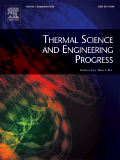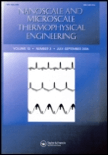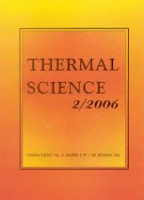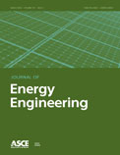
Thermal Science and Engineering Progress
Scope & Guideline
Elevating the standards of thermal science and engineering.
Introduction
Aims and Scopes
- Thermal Energy Management:
Research related to the optimization and management of thermal energy systems, including heating and cooling applications, energy storage solutions, and waste heat recovery. - Heat Transfer Technologies:
Studies focused on enhancing heat transfer processes, including experimental and computational investigations into heat exchangers, thermal interfaces, and phase change materials. - Renewable Energy Systems:
Exploration of renewable energy technologies such as solar thermal systems, biomass energy conversion, and hybrid energy systems, emphasizing their thermal performance and efficiency. - Numerical Simulation and Modeling:
Development and application of numerical models for simulating thermal phenomena in various systems, including computational fluid dynamics (CFD) and advanced heat transfer modeling techniques. - Innovative Materials and Nanotechnology:
Research on nanomaterials and composites aimed at improving thermal properties and performance in thermal applications, including phase change materials and nanofluids. - Sustainability and Environmental Impact:
Investigations into the environmental aspects of thermal energy systems, focusing on energy efficiency, emissions reduction, and the integration of sustainable practices in thermal engineering.
Trending and Emerging
- Hybrid Energy Systems:
There is a growing trend in research on hybrid energy systems that combine different energy sources, such as solar and biomass, to optimize energy production and reduce environmental impact. - Machine Learning Applications:
The integration of machine learning techniques in thermal management and optimization is emerging as a significant theme, showcasing the potential for data-driven approaches to enhance thermal system performance. - Thermal Energy Storage Solutions:
Research focusing on advanced thermal energy storage systems, particularly utilizing phase change materials (PCMs) and nanomaterials, is gaining traction due to their potential for improving energy efficiency. - Sustainable Thermal Management:
An increase in studies addressing sustainable practices in thermal management, including the use of green refrigerants, energy recovery systems, and designs aimed at minimizing environmental impact, is evident. - Advanced Heat Transfer Techniques:
Emerging research on innovative heat transfer enhancement techniques, including the use of nanofluids, microchannels, and hybrid systems, is becoming more prominent as industries seek to improve efficiency.
Declining or Waning
- Traditional Combustion Systems:
Research on conventional combustion systems, particularly in transportation and stationary applications, has shown a decrease as the focus shifts towards cleaner technologies and alternative fuels. - Basic Thermal Dynamics:
The study of fundamental thermal dynamics principles appears to be waning in favor of more applied and interdisciplinary approaches that integrate thermal science with advanced materials and technologies. - Single-Focus Experimental Studies:
There is a noticeable decline in publications centered on single-variable experimental studies, indicating a shift towards more complex, multifactorial research that reflects real-world applications. - Conventional Refrigeration Systems:
Research on traditional refrigeration systems, especially those using high-GWP refrigerants, is diminishing as the industry moves towards low-GWP alternatives and innovative cooling technologies.
Similar Journals

Energy Science & Engineering
Unlocking Potential in Renewable Energy and Risk ManagementEnergy Science & Engineering, published by WILEY, serves as a leading open-access platform for the dissemination of high-quality research and insights in the fields of energy science, engineering, and safety. Since its inception in 2013, this esteemed journal has gained recognition for its impactful contributions, reflected in its impressive impact factor and notable Scopus rankings. As of 2023, it holds a distinguished Q2 category ranking in both Energy (miscellaneous) and Safety, Risk, Reliability, and Quality, showcasing its vital role in advancing interdisciplinary collaboration and innovation. With an open access model, the journal ensures that groundbreaking research reaches a wide audience, fostering discussion and knowledge sharing across academia and industry. The scope of the journal encompasses cutting-edge topics related to energy efficiency, renewable energy technologies, and risk management, making it an essential resource for researchers, professionals, and students aiming to contribute to the evolving landscape of energy science and enhance societal sustainability.

Nanoscale and Microscale Thermophysical Engineering
Exploring Heat Transfer at the Nanoscale and MicroscaleNanoscale and Microscale Thermophysical Engineering is a leading scholarly journal published by Taylor & Francis Inc, focusing on the latest advancements in the fields of heat transfer, thermophysical properties, and nanoscale and microscale phenomena. With an ISSN of 1556-7265 and an E-ISSN of 1556-7273, this journal has established itself as a critical resource within the scientific community since its inception in 2006. The journal is ranked in the Q2 category across several disciplines, including Atomic and Molecular Physics, Condensed Matter Physics, Materials Science, and Mechanics of Materials, reflecting its significant contribution to ongoing research and development. Researchers and professionals in related fields benefit from its open access options, facilitating a wider dissemination of innovative findings and methodologies. With a commitment to addressing contemporary challenges in thermophysical engineering at the nanoscale and microscale levels, this journal not only fosters academic discussion but also accelerates technological breakthroughs and applications in various industries.

Thermal Science
Unveiling the science behind renewable energy systems and their impact.Thermal Science is an esteemed open-access journal published by the Vinca Institute of Nuclear Sciences in Serbia. With a rich focus on the field of thermal science, this journal has established itself as a vital resource for researchers and professionals interested in the dynamics of energy, renewable energy systems, and environmental sustainability. Since its inception in 2001, Thermal Science has dedicated itself to disseminating high-quality research that addresses the challenges of contemporary thermal technologies. The journal has converged its years of publication from 2007 to 2024 and currently holds a Q4 ranking in the category of Renewable Energy, Sustainability, and the Environment, with a Scopus rank of #172 out of 270, placing it in the 36th percentile. This makes it a crucial platform for sharing innovations and findings that contribute to the development of sustainable energy solutions. With open access options available, Thermal Science ensures that knowledge is readily accessible, fostering collaboration and advancement in this critical field.

Case Studies in Thermal Engineering
Exploring Breakthroughs in Fluid Flow and TransferCase Studies in Thermal Engineering, published by ELSEVIER, stands as a premier platform for innovative research and analysis in the field of thermal engineering since its inception in 2013. With a robust Open Access model, this journal ensures that groundbreaking findings in fluid flow and transfer processes are readily accessible to a global audience, fostering collaboration and knowledge sharing across disciplines. Situated in the United Kingdom, the journal boasts an impressive impact factor, reflecting its status in the first quartile (Q1) for both engineering (miscellaneous) and fluid flow and transfer processes, as noted in the latest Scopus rankings. Researchers and professionals alike recognize its significance, ranking 9th out of 96 in Chemical Engineering and achieving a notable 91st percentile in its category. By publishing high-quality case studies, the journal aims to advance understanding and applications of thermal engineering principles, making it an essential resource for those looking to stay at the forefront of this dynamic field.

JOURNAL OF ENERGY ENGINEERING
Unveiling the Future of Energy EngineeringJOURNAL OF ENERGY ENGINEERING, published by the ASCE-Amer Soc Civil Engineers, serves as a pivotal resource in the fields of civil and structural engineering, energy engineering, and nuclear energy research. With an ISSN of 0733-9402 and an E-ISSN of 1943-7897, this esteemed journal demonstrates a consistent commitment to advancing knowledge in energy systems, sustainability, and waste management. Ranking within the second quartile in several categories—including Civil and Structural Engineering and Energy Engineering and Power Technology—this journal maintains a strong reputation, underscored by its Scopus rankings that place it in the top tiers of its discipline. Accessible from 1982 through 2024, the journal provides researchers and professionals meaningful insights through rigorously peer-reviewed articles, critical reviews, and case studies that address contemporary challenges in energy utilization and infrastructure development. Without open access options, it ensures the integrity and credibility of published work, showcasing influential research that contributes to sustainable solutions in energy and environmental frameworks. Researchers, professionals, and students alike will find the JOURNAL OF ENERGY ENGINEERING an indispensable platform for exploration and dissemination of innovative ideas within the realm of energy and engineering.

International Journal of Heat and Technology
Fostering Excellence in Thermal Engineering InsightsThe International Journal of Heat and Technology is a premier academic publication dedicated to the dissemination of innovative research in the fields of thermal engineering, fluid mechanics, and condensed matter physics. Published by the INT INFORMATION & ENGINEERING TECHNOLOGY ASSOCIATION and based in Italy, this journal has been a significant resource for researchers and professionals since its inception in 1983, with a commitment to advancing knowledge until 2024. With an impact factor that reflects its relevance, the journal encompasses diverse topics within its scope, bridging gaps between theoretical research and practical applications. Although currently not open access, the journal provides valuable insights into the nuances of heat transfer, flow dynamics, and material properties, making it a critical reference for academia and industry alike. The journal's Scopus rankings position it within the competitive landscape of chemical and mechanical engineering, highlighting its contribution to advancing these fields. We invite scholars, professionals, and students to engage with the rich content provided within its pages, to foster a deeper understanding of heat and technology in our rapidly evolving world.

Thermophysics and Aeromechanics
Catalyzing Research in Aerospace and Energy EngineeringThermophysics and Aeromechanics, published by PLEIADES PUBLISHING INC, is an esteemed journal dedicated to advancing the fields of aerospace engineering, energy engineering, modeling and simulation, as well as nuclear and high energy physics. With an ISSN of 0869-8643 and E-ISSN 1531-8699, this journal serves as a vital platform for researchers and professionals working at the intersection of thermophysics and aeromechanics, delivering cutting-edge research, reviews, and case studies. Despite its current position in Quartile Q4 across multiple categories, including aerospace and energy engineering, it provides a unique opportunity for emerging ideas in these domains to gain visibility and impact. The journal's convergence of diverse scientific disciplines is critical for fostering innovation and technological advancements, making it an essential resource for students, practitioners, and academics alike. In this era of rapid scientific development, Thermophysics and Aeromechanics plays a pivotal role in disseminating knowledge and facilitating interdisciplinary collaboration among a global audience.

Journal of Engineering Thermophysics
Connecting theory and practice in the realm of thermophysics.Journal of Engineering Thermophysics, published by PLEIADES PUBLISHING INC, is a premier academic journal dedicated to advancing the field of thermophysics and its applications across a variety of engineering disciplines. With an ISSN of 1810-2328 and an E-ISSN of 1990-5432, this journal offers an essential platform for researchers and professionals to disseminate cutting-edge findings on the interplay between thermal processes and engineering systems. As of 2023, it is recognized within the Q3 category in key fields such as Condensed Matter Physics, Energy Engineering and Power Technology, Environmental Engineering, and Modeling and Simulation. Moreover, the journal contributes to an important dialogue in the environmental sciences, ranking 111 out of 197 in Environmental Engineering, and positions itself prominently within the academic landscape from its establishment in 2007. Although currently not an open-access journal, it facilitates a selective yet impactful communication of research that drives innovation and knowledge in the thermal sciences. For those engaged in understanding the thermal dynamics essential for sustainable engineering solutions, the Journal of Engineering Thermophysics is the go-to resource for published research, reviews, and advancements in the field.

JOURNAL OF ENHANCED HEAT TRANSFER
Advancing the Frontiers of Heat Transfer ResearchThe JOURNAL OF ENHANCED HEAT TRANSFER, published by BEGELL HOUSE INC, is a prominent resource for researchers and professionals in the fields of mechanical engineering, fluid flow and transfer processes, and condensed matter physics. With a history spanning from 1993 to 2024, this journal offers a platform for disseminating cutting-edge research and innovations that enhance our understanding of heat transfer phenomena. Although it operates under a traditional subscription model, its impressive standing is underscored by its Scopus rankings—positioned within the 59th percentile for Mechanical Engineering and 58th percentile for Fluid Flow and Transfer Processes. Additionally, it holds Q2 and Q3 categorizations in relevant fields, reflecting its importance in advancing knowledge and applications in heat transfer technology. This journal effectively bridges the gap between theoretical insights and practical solutions, making it an indispensable tool for academics, industrial practitioners, and students eager to explore advancements in thermal management and efficiency.

Journal of Thermal Science
Fostering groundbreaking research in thermal applications.Journal of Thermal Science is a prestigious academic publication dedicated to the field of thermal science and its applications. Published by SPRINGER, this journal has been at the forefront of knowledge dissemination since its inception in 1992 and continues to provide a platform for researchers and professionals to share their innovative findings through high-quality peer-reviewed articles. With its ISSN 1003-2169 and E-ISSN 1993-033X, the journal covers a diverse array of topics related to thermal processes, materials, and engineering, significantly contributing to advancements in Condensed Matter Physics. In the latest rankings, it holds a commendable Q2 category in the 2023 quartiles, further highlighting its relevance with a Scopus ranking of #183/434 in its field, placing it in the top 57th percentile. While currently not offering open access, the journal strives to bridge the gap between theory and practice, making substantial impacts on both academia and industry. Its continued exploration of cutting-edge research ensures that it remains a key resource for students and professionals looking to expand their knowledge and foster innovation in thermal sciences.